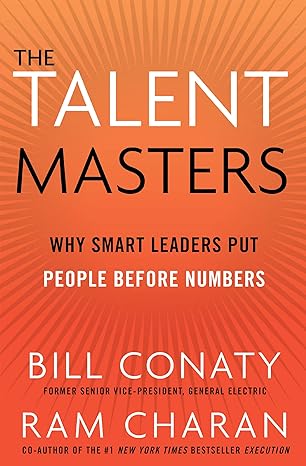
The Talent Masters: Why Smart Leaders Put People Before Numbers - by Bill Conaty & Ram Charan
Date read: 2017-02-01How strongly I recommend it: 6/10
(See my list of 150+ books, for more.)
Go to the Amazon page for details and reviews.
Focuses on the need for any business to constantly focus on developing and nuturing talent. Examples from GE, LG, and Unilever.
Contents:
My Notes
Talent masters can identify a person's talent more precisely than most people because they excel at observing and listening.
An enlightened CEO recognizes that his top priority for the future is building and deploying the talent that will get it there.
We find that such leaders invest at least a quarter of their time in spotting and developing other leaders.
Differentiation breeds meritocracy; sameness (the failure to differentiate people) breeds mediocrity.
One value we see among talent masters is the obligation of leaders to develop other leaders.
Talent masters work strenuously to ensure trust by insisting on candor in all of the company's dialogues, whether one-on-one, in group settings, or in appraisals.
He wanted leaders, not managers. How would this person deal with people and develop them? Did he have the self-confidence to find and develop people better than himself? Could he see what was coming from the outside and deal with it? Finally, he wanted leaders who could put their own near-term interests on hold for the good of the company.
Performance - getting results - is viewed as the ticket of admission; it's expected as a matter of course. But leadership values determine whether a person will rise in the organization.
HUL has refined a singularly powerful tool for assessing candidates. It brings several applicants at a time together with HR people and senior managers to discuss a specific business issue in groups. The discussions bring out whether individuals "have it all" - not only the functional skills but also the judgment, integrity, and temperament required to make good decisions and build and maintain relationships. In particular, they put a spotlight on getting things done in ways others will admire and want to follow.
Developing talent through experiences expands capability and capacity in the four major components of talent: personal traits, skill mix, relationship building, and judgment about people and business.
Becoming aware of and dealing with your inner core is at the center of leadership effectiveness and development.
The greater the scope of a decision and the more variables and uncertainties there are, the more important it is for the leader to be aware of unconscious drives and biases that could affect emotions, reason, and intuition.
He distills his learning into five principles that he wanted Goodyear's leadership talent to reflect: Business is a team sport; it isn't ultimately about individuals. The best decisions don't come from the smartest person in the room; they come from a group of smart people gathered in the room. Leaders need to know what they don't know. Leaders must be courageously innovative. Leaders must be passionate about their business but remain unemotional when making key decisions.
People have to know beyond a doubt that they are expected to search for and develop other leaders' talent, and to do so with the same drive for accuracy that they apply to operations and finance.
If one person says he thinks a certain person would be best for a bigger job, we'll ask him, ‘If that person were outside Goodyear and submitted a resume for that job opening, would he be the one you would hire?' When you do that they start to get it, they understand better what to look for and how to evaluate people."
Selecting Leaders:
Developing Leaders:
Making Leadership Assignments:
Assessing Leaders:
Recognizing and Retaining Leaders: